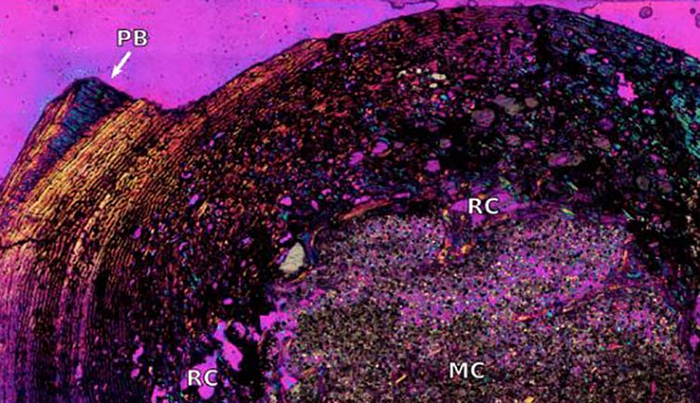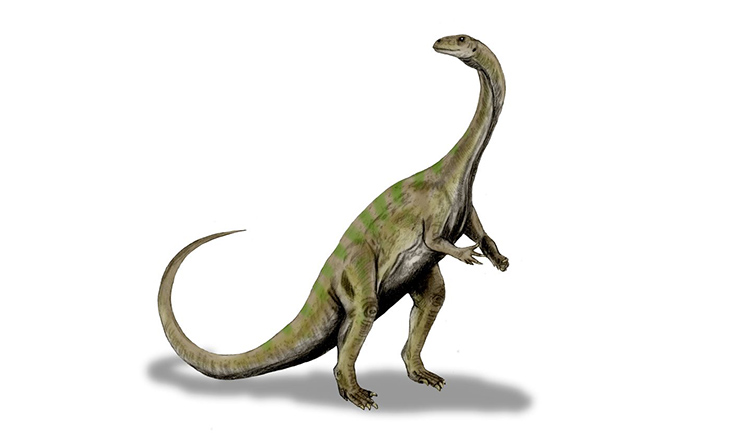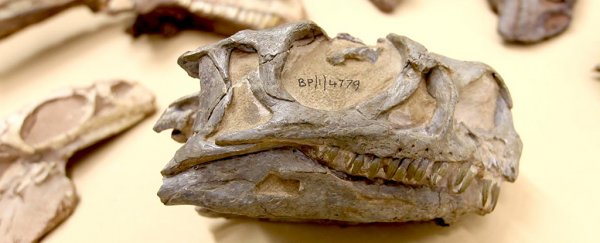Sometimes the discovery of a new dinosaur species doesn't require an extensive archaeological dig – it just needs a closer analysis of the dino bones already sitting in the collection of a university. That's turned out to be case with the newly described Ngwevu intloko.
The new species, now named "grey skull" in the South African Xhosa language, had originally been categorised as a slightly odd specimen of Massospondylus carinatus, one of many items in the Evolutionary Studies Institute (ESI) collection at the University of the Witwatersrand, South Africa.
More than 40 years after the remains were found, experts have now come to the conclusion that these bones don't belong to M. carinatus at all. Detailed computed tomography or CT scans have revealed key differences between the species.
 Fossil bone slices were used to date the dinosaur. (Kimberley Chapelle)
Fossil bone slices were used to date the dinosaur. (Kimberley Chapelle)
"This is a new dinosaur that has been hiding in plain sight," says palaeontologist Paul Barrett from the Natural History Museum in London.
"The specimen has been in the collections in Johannesburg for about 30 years, and lots of other scientists have already looked at it. But they all thought that it was simply an odd example of Massospondylus."
One of the noted abnormalities of the preserved dino bones had previously been put down to a deformed skull, but the latest study showed no signs of breaking or twisting – this is a skull from a different species, not a deformed one.
Through close analysis of M. carinatus records, the team also ruled out the hypothesis that this skull and skeleton were different because of growth patterns. Differences between males and females were also discounted, as this typically doesn't affect skull shape.
By studying slices of bone, the researchers were able to estimate the age of the dinosaur, judging it to be a fully grown adult – and smaller than the typical M. carinatus adult.
"Studying how dinosaurs grew is a very important step in better understanding why some dinosaurs look different," says palaeontologist Kimberley Chapelle from the University of the Witwatersrand.
"This is a difficult task to accomplish with fossils because it is rare to have a complete age series of fossils from a single species. Luckily, the most common South African dinosaur Massospondylus has specimens ranging from embryo to adult."
The new categorisation can teach us more about how the world looked at the beginning of the Jurassic period, a little over 200 million years ago, when dinosaurs really began to rule the world.
The newly announced N. intloko dinosaurs would have walked on two legs, with a slender neck and a small, boxy head. At around three metres (almost ten feet) from nose to tail, it would've been one of the smaller dinosaurs of its time.
 M. carinatus looked like this, and N. intloko was probably similar. (Nobu Tamura/Wikimedia Commons)
M. carinatus looked like this, and N. intloko was probably similar. (Nobu Tamura/Wikimedia Commons)
The researchers think the dino was primarily a plant eater, though it may have snacked on some small animals that came across its path. All of this makes it very different from the large, plant-eating sauropods that we know from the later Jurassic.
This discovery tells us more about M. carinatus, too: long thought to be a "disaster taxon" (a species thriving in the wake of a natural disaster), this may not be the case. It's possible that the start of the Jurassic period saw much more diversity than was previously thought, too.
Now the question is whether more M. carinatus specimens have been misidentified – there could well be several N. intloko fossils out there.
"Recent work has now shown that there were actually lots of different types of dinosaurs back then," says Barrett.
"While we used to think that there was maybe one type of dinosaur, we now know there were actually six or seven sauropodomorph dinosaurs in this area, as well as variety of dinosaurs from other, less common groups."
The research has been published in PeerJ.
